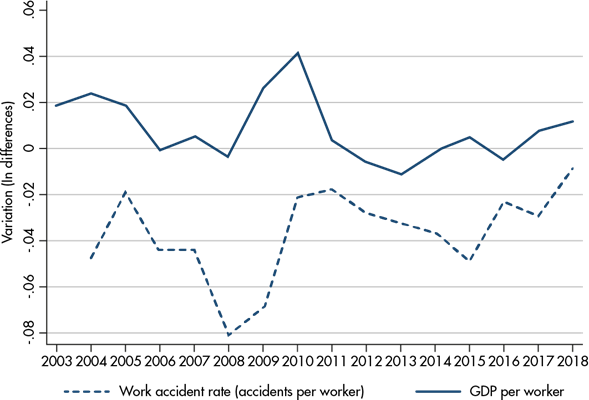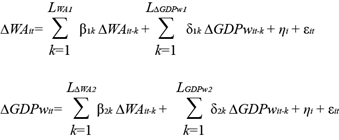This study evaluates the dynamic connections and potential causal relationships between macroeconomic figures linked to the economic cycle (i.e., gross domestic product (GDP) per worker) and work-related accidents in the United States during 2003-2018.
Work accidents have a major impact on workers and their families (GBD 2016 Occupational Risk Factors Collaborators (2020); GBD 2019 Diseases and Injuries Collaborators (2021). The costs of work accidents surpass economic figures and cover other more intangible aspects related to workers’ physical and psychological wellbeing in the short- and long-run (Takala et al., 2014; Hämäläinen et al., 2017; Piore & Schrank, 2018). Also, the productivity declines and disruptions in production processes that follow work accidents significantly damage business performance and, subsequently, territorial economic outcomes (Lafuente & Abad, 2021). Global figures made available by the ILO (2019) estimate that 374 million workers suffer from work accidents every year with an associated economic cost that represent roughly 4% of world’s GDP. The situation in the United States is equally tragic: the US Occupational Safety and Health Administration estimated that work-related accidents cost workers, businesses, and public administrations around US$171 billion in 2019 (URL: https://www.osha.gov/businesscase).
Occupational health and safety policies and practices are fundamental pillars for securing safer work environments and stimulating social wealth (Piore & Schrank, 2018). As a result, the territorial analysis of the relationship between the economic cycle and work accident rates has gained momentum among social planners, scholars, and managers (Davies et al., 2009; Li et al., 2011; Wu et al., 2018; ILO, 2019; Lafuente & Abad, 2021).
Empirical studies dealing with the analysis of the connection between the economic cycle and work accident rates often assume that these variables are intrinsically associated over time (Lafuente & Daza, 2020). Two narratives are the most prominent when it comes to theorizing the complex relationships between economic fluctuations and work accidents. First, the dominant narrative supporting the cyclical relationship between territories’ economic outputs and work accidents is rooted in the pioneering work by Kossoris (1938) . In this debate, it is argued that the economic cycle (expansion or recession stage) conditions businesses’ activity-in terms of resource exploitation and labor intensification-and, consequently, the temporal trajectory of work accident rates across territories. When the economy is growing businesses tend to increase production and employment figures to satisfy market demands. The intensification of productive activities will manifest in higher workloads (and stress and fatigue) and less attention to safety practices; thus, increasing both the exposure to work risks and work accidents (Dembe et al., 2005; Trinkoff et al., 2006; Lafuente & Abad, 2021). Existing research supports this argument. Gerdtham and Ruhm (2006) and Davies et al. (2009) found that in growth periods the increase in employment figures is accompanied by a greater reporting of work accidents. Also, Cioni and Savioli (2016) showed that poor working conditions are the main determinant of work accidents and occupational illnesses.
Second, the workers’ vulnerability approach by Nichols (1989) proposes various behavioral traits and labor-market factors to explain the fall in work accident rates in recession periods. In this sense, job insecurity increases in periods of economic decline, and studies suggest that the positive correlation between the economic cycle and work accidents during periods of economic downturn is caused by the lower willingness of workers to report accidents due to their market vulnerability (claim reporting effect linked to the fear of losing the job) (Nichols, 1989; Ruhm, 1996; Boone & van Ours, 2006). For example, using a unique matched (worker-firm) dataset on work accidents, Boone et al. (2011) found that, in Austria, economic recessions influence the reporting of moderate workplace accidents, that is, if workers perceive a higher probability of dismissal, they are less likely to report a moderate work accident.
But, at the territorial level various sources of heterogeneity-e.g., labor intensity and differences in work safety regulations across territories-might influence the temporal connection between macroeconomic figures and work accidents. In this sense, the statistical significance of the relationship between the economic cycle and the rate of work accidents is often presented as an indirect test of the effectiveness of work safety policy and practices (Dembe et al., 2005; Davies et al., 2009; Boone et al., 2011; Lafuente & Abad, 2021).
In the specific context of this study, important questions remain unanswered: is there a causal relationship between economic activity and work accidents in the US? And, if so, are the analyzed causality effects consistent across US States?
To answer these questions empirically, this study uses vector autoregression (VAR) models and Granger causality tests to verify the relationship between the economic cycle and work accident rates on a sample of 40 US States from 2003 to 2018.
The USA setting is attractive for various reasons. First, access to detailed data on work accidents allows to carry out a comprehensive analysis of the potentially causal relationship between the state of the economy and work accidents. Thus, this study updates the relatively limited evidence on the statistical connection between the economic cycle and work accident rates that is available for the US (Ruhm, 1996; Dembe et al., 2005; Leigh, 2011).
Second, by scrutinizing the potentially causal relationship between economic fluctuations (measured by changes in GDP per worker) and the rate of work accidents, this study offers the opportunity to assess the effects of the evolution of territories’ economic performance in contexts where the causes and consequences of work accidents are complex and heterogeneous.
Finally, by analyzing the connection between economic activity and work accidents this study sheds light on the importance of accounting for the configuration of the local industrial fabric when it comes to design occupational health and safety (OHS) policies that may contribute to reduce work accidents and, ultimately, lead to a greater economic consolidation.
The plan of the paper is organized as follows. Section 2 deals with the data and the description of the analytical method. Section 3 presents the empirical results, while Section 4 offers the concluding remarks, implications, and future research lines.
2. Data and empirical strategy
2.1 Data and variable definition
The data used in this study come from two sources of information. First, data on macroeconomic figures-i.e., Gross Domestic product (GDP)-was obtained from the Bureau of Economic Analysis databases (https://www.bea.gov/data/gdp). Second, the information on the number of work-related accidents was collected from the Bureau of Labor Statistics databases (https://www.bls.gov/iif/oshcdnew.htm).
This study evaluates the relationship between economic cycle (measured as variations in GDP) and work accidents in 40 States over the period 2003-2018. Table 1 summarizes the States included in the analysis according to the territorial segmentation set by the USA Census Bureau (URL: https://www.census.gov/programs-surveys/economic-census/guidance-geographies/levels.html).
Table 1: Sample: US States considered in the study.
The key study variables are the rate of work accidents and the GDP per worker. In the case of the former, the work accident rate is defined as the total number of work-related accidents divided by the total number of workers in the economy. It is worth mentioning that this variable represents the number of work-related accidents (i.e., minor and major injuries) and occupational illnesses per 100 full-time equivalent workers which is calculated as (N/EH) x 200,000, where N is the number of injuries and illnesses, EH is the total number of hours worked by all employees during the calendar year, and 200,000 is the base number of yearly working hours for 100 full-time equivalent workers (working 40 hours per week during 50 weeks).
Concerning the macroeconomic data, the States’ economic activity or output is measured by the GDP per worker. This variable, which is a proxy of labor productivity, has been extensively used in economic studies dealing with territories’ economic performance (Caselli & Coleman, 2006; Lafuente et al., 2020). Descriptive statistics in levels and log differences are presented in Table 2.
Table 2: Descriptive statistics for the selected variables (US aggregate data during 2003-2018)
For illustrative purposes, a first descriptive indication of the potential cyclical relationship between work accidents and economic activity is presented in Figure 1. For ease of interpretation, the figure shows the variation rate in both study variables-i.e., rate of work accidents and GDP per worker-over the analyzed period. Previewing the results, the figure suggests that fluctuations in the analyzed variables follow a similar trajectory over time.
2.2 Empirical strategy
This study emphasizes the relationship between economic activity and the rate of work accidents in the United States. To achieve this objective, I followed a two-step methodology based on vector autoregression models (VAR) for time series (Sims, 1980) and panel-data settings (Holtz-Eakin et al., 1988).
In the first stage, a standard VAR model is used to analyze the connection between the aggregate (USA level) time series of variations in GDP per worker and changes in work accident rates. Here the balanced VAR model-i.e., with the same lag length for all variables-has the following form:
In the full specification presented in equation (1) ∆WA is the variation in the work
accident rate and ∆GDPw is the variation in GDP per worker during the study period (t = 1, ,T). The
coefficients α are the intercepts, while β and δ are parameters capturing the short-run effect on the
dependent variable of the variables ∆WA and ∆GDPw, respectively. The terms ε are the flat noise
of the VAR model. Notice that in each equation the short-run effect (SR) is defined as the sum of the
coefficients of all variables lagged k periods (for example, the short-run effect of ∆GDPw on
∆WA in the ∆WA equation is  ) (Lütkepohl, 1993).
) (Lütkepohl, 1993).
Second, I employ a panel-data VAR model (Holtz-Eakin et al., 1988) to study the connection between variations in GDP per worker and changes in the rate of work accidents at the State level (i= 1, ,N). In this case the following panel VAR model is used:
Keeping the notation used in equation (1), in equation (2) ∆WA is the variation in the work accident rate, ∆GDPw is the variation in GDP per worker, the terms β and δ are vectors of parameters to be estimated, ηi is the State-specific fixed effects term, and εit is the idiosyncratic error term. Following Holtz-Eakin et al. (1988) , the panel-data VAR model in equation (2) assumes that, for the studied States, coefficients (β and δ) are estimated by a homogeneous data generation process. Equation (2) is computed using the GMM estimator (Arellano & Bond, 1991).
With model estimations in hand (equations (1) ad (2)), the Granger causality Wald test (Abrigo & Love, 2016), which evaluates whether one times series is useful in forecasting another (null hypothesis: all parameters on the lag of the study variables are jointly zero in each equation), is used to verify a causal relationship between economic activity and work accident rates. Results are presented in the next section.



